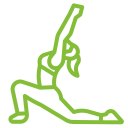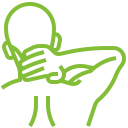Fitness Profile
Find out more about how your genetic makeup impacts your fitness
- Aerobic performance
VO2 max (maximal aerobic capacity) is the maximum rate of oxygen uptake as measured during incremental exercise, most typically on a motorized treadmill. Maximal oxygen uptake reflects the aerobic physical fitness of the individual, and is an important determinant of their endurance capacity during prolonged, submaximal exercise. . Just a few of the benefits of aerobic fitness are lower blood pressure, lower cholesterol and less risk of obesity, Type II diabetes and heart disease. Aerobic performance measured as the maximal rate of oxygen consumption (VO2max) is an important determinant of the endurance capacity during prolonged exercise. VO2 max (V - volume, O2 - oxygen, max - maximum) is measured during incremental exercise. Overall, maximal oxygen consumption reflects the aerobic physical fitness of the individual, and it is widely accepted as the single best measure of cardiovascular fitness and maximal aerobic power. Absolute values of VO2 max are typically 40-60% higher in men than in women. Starting at about the age of 30, our lung capacity begins to decrease. By the time we are 50 our lung capacity may be half of what it was in our youth. Decreased lung capacity means respiratory function is impaired and less oxygen is getting into our cells. This explains why shortness of breath, decreased endurance, and susceptibility to respiratory illness commonly increases with age. We check for several genetic variants that are associated with aerobic performance.
- Elite Endurance Athletes
Elite endurance athletes, such as distance runners, road cyclists and triathletes, excel in aerobic performance. They are more likely to have higher proportion of slow-twitch (type I) muscle fibers. In addition, elite endurance athletes have a superior cardiovascular system that maintains optimal control of heart rate, stroke volume, and blood pressure. Elite athletes are likely to have increased fat oxidation capacity and higher lactate threshold that ensures their muscles can function for longer periods of time. Assuming proper nutrition and training, athletic endurance is, in simplest terms, limited by a human's ability to extract oxygen from the environment and deliver it to muscle cells that use it to generate energy. Lifenome computes genetic predisposition likelihood for elite endurance based on 23 genetic variants, taking into account genetics-based endurance and aerobic performance scores.
- Endurance
Your muscle endurance measures your ability to repeat an activity for an extended period of time without getting tired. If your muscle structure favors endurance you have the potential to thrive in exercises that leverage your endurance. Cross-country skiing and push-ups are examples of endurance exercises.The intrinsic capacity to perform endurance exercise is influenced by a number of factors. First of all, endurance depends on the proportion of slow-twitch fibers in the skeletal muscle. Studies have identified a number of genetic variants associated with higher proportion of slow-twitch fibers, and higher oxygen supplies to muscle tissues. Slow twitch fibers are also called red fibers because they contain more blood-carrying myoglobin. The red muscles provide their own source of energy using oxidative phosphorylation to obtain ATP. Therefore, slow-twitch fibers can sustain force for an extended period of time.
- Exercise Aversion
Your motivation for physical activity is partly influenced by your genetics. How your body feels during a workout (e.g oxygen transportation and lung capacity), and how you are predispositioned to respond mentally to the challenge all come down to your genetic makeup. Studies indicate that up to 50% of your like or dislike for exercise comes down to your DNA. There is a difference between exercise aversion and a lack of motivation, where the former is a stronger inhibition factor. If you have specific genetic variations, it may result in a lower biological desire to engage in physical activity making exercise your least favorite activity.
- Joint Flexibility
While flexibility and range of motion can be improved with regular stretching, some people have inherent joint flexibility that is a highly heritable trait. Genetic variants in several collagen genes alter amino acid sequence and change the amount of collagen proteins being produced affecting architecture and biomechanical properties of some tissues, including ligaments. Therefore, people with these genetic variants in general have higher range of motion and better joint laxity and flexibility. Interestingly, the research has shown that violinists, flautists, and pianists with lax finger joints suffer less pain than their less flexible peers. An opposite spectrum of this is risk of non-contact soft tissue injuries while doing very active sports. Other genetic variants in the collagen genes reduce joint flexibility and potentially protect from cruciate ligament, shoulder dislocation, and anterior cruciate ligament ruptures.
- Lean Body Mass Potential
Your lean body mass is the portion of your weight that is not fat. Your lean body mass is actually composed of your muscle and bone tissue as well as the water in your body and your organs – everything except the fat beneath the surface of your skin. Leaner body mass has a strong genetic component. If you are predisposed to having a higher lean body mass, you have a better chance of attaining a muscular body through fitness exercises than the average population. Higher lean body mass also decreases the likelihood of excessive body weight, obesity, impaired protein balance, osteoporosis and sarcopenia.
- Low Resting Metabolic Rate
Body weight depends on the balance between energy intake and energy expenditure. Energy intake comes from calories consumed, and energy expenditure is the energy that body uses to maintain normal body temperature and essential processes such as metabolism, breathing, brain functioning. Individual differences in the energy cost of self-maintenance (resting metabolic rate, RMR) are substantial, and depend on age, weight, environment, and genetics. The heritability of RMR is 40-50% of the variance remaining after adjustment for age, gender, and fat-free mass. Uncoupling proteins, UCP1 and UCP3, play important roles in regulating body temperature and energy expenditure: these proteins are found in brown fats and they are involved in metabolic process by which energy is dissipated as heat in response to excess of caloric intake and cold stress. People with genetic variations in the UCP genes tend to have lower RMR.
- Power
Your muscle power measures the maximum amount of force you can exert in a limited period of time. When your muscle structure favors power exercises, you have the potential to exert substantial force in a short period of time. Olympic weight lifting is an example of a power exercise. The heritability of power/strength has been estimated to be up to 80% depending on the specific muscle type (isometric knee strength, handgrip strength, elbow flexion). Fast-twitch (Type II) fibers generate a relatively high amount of force in a short period of time. They are characterized by high force/power/speed, like the take-off motion in a sprint, but the fast-twitch muscle fibers experience fatigue faster. “Power” fibers have lower mitochondrial density, lower myoglobin levels but higher levels of stored glycogen as they primarily rely on glycosis (anaerobic respiration) to fuel muscle contractions. The glycolysis process is very quick yet it is also quite inefficient at producing ATP. Another drawback of glycolysis is that it produces lactic acid as a byproduct, which leads to muscle fatigue. This explains why fast twitching muscles tire out quicker. To evaluate your power profile predisposition likelihood Lifenome uses the most reliable genetic biomarkers that have been found to be associated with power/strength-related sports.


Fitness Benefits
Gain insights on what the actual benefits of exercise can be on your unique biology
- Exercise Benefits for Blood Pressure
For most people, moderate-intensity exercise has been shown to lower blood pressure. In fact, aerobic exercise training is generally recommended as lifestyle therapy to prevent, treat and control hypertension. General guidelines call for at least half an hour of low intensity aerobic exercises, which helps to decrease blood pressure.
There is large variability in the individual response to the anti-hypertensive effect of exercise, and much of it is explained by genetic variations. Individuals with predisposition to increased hypertension response, get to lower their blood pressure faster than the average population. For such individuals, the benefits of this 30 minute exercise are more noticeable than for the average population.
- Exercise Benefits for Lowering Cholesterol
Research has shown that exercise stimulates enzymes that help move bad cholesterol from the blood to the liver, allowing it to be excreted as bile. It is also stipulated that exercise increases the size of the protein particles that carry cholesterol through the blood, reducing the possibility that smaller particles may clog arteries.
People with some genetic variants will have good results at increasing levels of good cholesterol by exercise alone, while carriers of other genetic variants are less likely to succeed to lower bad cholesterol levels by exercise alone.
- Exercise Benefits for Maximal Oxygen Uptake Response
VO2 max (also maximal oxygen consumption, maximal oxygen uptake, peak oxygen uptake or maximal aerobic capacity) is the maximum rate of oxygen consumption as measured during incremental exercise, most typically on a motorized treadmill.
One of the exercise benefits is improvement in maximal oxygen uptake response. When you exercise your muscles are working harder than normal and, as a result, they require more energy than normal.
Since the ATP energy used by your muscles is generated with the aid of oxygen, it follows that an increase in exercise intensity will result in an increase in muscular oxygen demands. Therefore, increased exercise intensity ultimately corresponds to an increased VO2.
This is the reason that your breathing gets progressively faster and deeper as your exercise intensity increases, your body is trying to provide more oxygen to your working muscles so that they can generate enough ATP energy to keep you moving. People with differences in genetics, gender, age and fitness state respond differently to the same exercise training program. At least 50% of these differences have been found to be due to genetic variations.
- Heartbeat Reduction Difficulty
Heart rate response is commonly used as a measurable marker to guide exercise intensity and to monitor progress with the expectation that the heart rate at a given intensity and load will decrease substantially with regular exercise.
Exercise training improves cardiac function and several cardiovascular risk factors, including ability to perform physical tasks at a given workload with a lower heart rate. However, the cardiovascular benefits of regular physical activity are not equally distributed among individuals, as some exhibit marked improvements while others may show little or no changes. If you have higher predisposition to reduced heart response to exercise, the expected decrease in exercise heart rate may not occur.
You or your fitness specialist may (falsely) assume that the exercise prescription was insufficient and may try to increase the exercise training load. Genetic variation explains large proportion of this difference. It is important to know this to make sure that the exercise does not cause undue heart strain.
- Lower Exercise Benefits for Heart Pump Function
Cardiac output is the volume of blood being pumped by the heart in a minute. It is equal to the heart rate multiplied by the stroke volume. So if there are 70 beats per minute, and 70 ml blood is ejected with each beat of the heart, the cardiac output is 4900 ml/ minute.
A large family study reported that a 20 week endurance training program resulted in a mean increase of 3.9 ml/beat in stroke volume measured during steady-state exercise at 50 W (SV50) . Interestingly, the individual training responses ranged from a decrease of 41 ml/beat to an increase of 45 ml/beat. Carriers of a genetic variant in the kinesin heavy chain (KIF5B) gene had lower SV50 training response than carries of the more common allele.
- Overall Fitness Benefits
The health benefits of regular exercise and physical activity are hard to ignore. Everyone benefits from exercise, regardless of age, sex or physical ability.
Exercise can help prevent excess weight gain or help maintain weight loss. Regular exercise helps prevent or manage a wide range of health problems and concerns, including stroke, metabolic syndrome, type 2 diabetes, depression, a number of types of cancer, arthritis and falls. Exercise delivers oxygen and nutrients to your tissues and helps your cardiovascular system work more efficiently. And when your heart and lung health improve, you have more energy to tackle daily chores.
Some people show quick and strong benefits, while others need more exercise and changes to their diets too. For people with some genetic variants, active life-style was shown to produce quick results to lower levels of cholesterol, triglycerides, and blood pressure.
Injury Potential
Explore how your unique genetic makeup makes you more or less vulnerable to tendon and/or joint injury risks
- Achilles Tendinopathy
Achilles tendon injury includes degenerative and painful conditions that affect athletes in a wide range of sports, including up to 20% of runners. This is a multifactorial condition for which various genetic risk factors have been identified. Genetic variants in the FBGN2, TNC and ADAMTS14 (metallopeptidase with thrombospondin) gene contribute to the reisk of achilles tendinopathy, while genetic variant in the MMP3 has been found to be protective.
- Anterior Cruciate Ligament Rupture
Anterior cruciate ligament (ACL) ruptures are considered to be the most severe joint injury in sports and is very common in a sporting population. Athletes who participate in high demand sports like soccer, football, and basketball are more likely to injure their anterior cruciate ligaments. Athletes are involved with sudden deceleration of the body from jumping and forward running while the knee is in a shallow flexion angle. On the other hand, ACL injuries are not common among athletes involved in endurance sports, such as running, swimming, biking. About half of all injuries to the anterior cruciate ligament occur along with damage to other structures in the knee, such as articular cartilage, meniscus, or other ligaments.
Injured ligaments are considered "sprains" and are graded on a severity scale.
Grade 1 Sprains. The ligament is mildly damaged in a Grade 1 Sprain. It has been slightly stretched, but is still able to help keep the knee joint stable.
Grade 2 Sprains. A Grade 2 Sprain stretches the ligament to the point where it becomes loose. This is often referred to as a partial tear of the ligament.
Grade 3 Sprains. This type of sprain is most commonly referred to as a complete tear of the ligament. The ligament has been split into two pieces, and the knee joint is unstable.
There are some genetic variations that are commonly found in individuals with higher risk of ACL ruptures.
- Joint Injury Risk
Many sports-related injuries involve damage to the joints. Common joint injuries include a twisted ankle, sprained wrist, overextended elbow, and damaged knee ligaments. When exercising you can be more at risk for overuse injuries. But you can build strength in your joints and avoid joint injuries by stretching and exercising correctly.
The risk of joint injury is associated with higher genetic predisposition to osteoarthritis. Knowing about this risk is important in adjusting duration and intensity of training sessions. Sports and high-impact activities lead to cartilage lesions, and may lead to joint injuries. Your risk for the joint injury is computed based on 13 genetic variations that were found to be associated with joint problems.
- Overall Tendon and Ligament Injury Risk
Non-contact tendon or ligament injury is an overuse injury associated with sports, and are a common cause of disability. Most major tendons, such as the Achilles, patellar, rotator cuff and forearm extensor tendons (amongst others) are vulnerable to overuse, which induces pathological changes in the tendon. Knowing your genetic susceptibility to specific injury will help in customization of exercise recommendations, choosing the right prevention strategies like avoidance of weight-bearing and high-impact sports for individuals who have risk profile genotypes would take advantage of this information.
- Stress Fracture
Stress fractures are small cracks in a bone. Stress fractures are caused by the repetitive application of repetitive movements, or force. For example, running long distances or repeatedly jumping up and down.
Stress fractures can also arise from normal use of a bone that's been weakened. Anyone can experience a stress fracture, but some people have higher predisposition which is associated with lower bone mass density.
Stress Fracture is a common overuse injury in repetitive sports. It affects up to 20% of athletes, in particular female athletes. The major determinant of stress fracture risk is bone mineral density that has large genetic component up to 85% of bone mineral density variability is explained by genetic variations). We use information on dozens of genetic variants to estimate your risk of stress fracture. Some genetic variations increase the risk of stress fracture while others have protective roles.


Characteristics
Muscle Characteristics
Explore the genetic basis of your muscle characteristics
- Muscle Damage Risk
A muscle strain, or pulled muscle, occurs when your muscle is overstretched or torn. This usually occurs as a result of fatigue, overuse, or improper use of a muscle.
Strains can happen in any muscle, but they’re most common in your lower back, neck, shoulder, and hamstring, which is the muscle behind your thigh. Muscle damage can be caused by different reasons, including increased lactate oxidation, deficient lactate efflux pathways, or release of intracellular muscle components into the bloodstream.
Mutations in some genes in these pathways are associated with rare condition known as cryptic exercise intolerance. Common genetic variation in the same genes have been found to be associated increased risk of muscle injury, muscle cramping, and lactate accumulation in the muscle.
This genetic variation has been associated with incidences of muscle injuries in elite football players. A predisposition to increased muscle damage risk can mean that you have to be more careful about lifting heavy weights or making sudden moves than the average person. Additionally, you may want to focus your exercises on those that improve the tenacity and flexibility of your muscles.
- Muscle Response to Resistance Training
Muscle-strengthening are recommended to be included in fitness routines for a minimum of 2 days a week. Long-term systematic resistance training increases skeletal muscle size and strength in both men and women of different ages.
While studies demonstrate that nearly all individuals will get some benefit from RT, RT-induced gains in muscle size and strength are highly variable between individuals. Muscle strength and size gains following standardized program depend on gender, age, general health, nutrition, and genetics.
Several studies reported associations with muscle strength and size. People with some genetic variations gained higher (isometric) muscle strength and biceps size in response to the same resistance training routine.
- Muscle Soreness
The delayed onset muscle soreness refers to the feeling of soreness 12-24 hours after heavy exercise. It is commonly understood to be the result of microscopic tears in your muscle tissue. The mild muscle strain injury creates microscopic damage to the muscle fibers and coupled with the resulting inflammation causes the pain. The less fit you are, the more likely it is for your muscles to feel sore.
If you have a higher predisposition towards muscle soreness, you may want to only gradually increase the intensity of your workouts and concentrate more on endurance exercises that put less pointed pressure on your muscles. Genetic variants in some inflammation-related genes (IGF2) were found to be related to the greatest muscle soreness immediately after exercise, and highest post-exercise serum creatine kinase activity.
- Muscle Strength Loss
From the time you are born to around the time you turn 30, your muscles grow larger and stronger. But at some point in your 30s, you start to lose muscle mass and function. The cause is age-related sarcopenia. Physically inactive people can lose as much as 3% to 5% of their muscle mass each decade after age 30. Even if you are active, you’ll still have some muscle loss.
The speed by which we lose muscle strength when we stop exercising, depends on a variety of factors, such as age, diet and the amount of sleep that we get. Sometimes even two weeks of physical inactivity can result in substantial muscle strength loss. Genetic variants in some inflammation-related genes (IGF2) were found to be related to the greatest muscle strength loss after exercise.
- Muscular Strength
Muscular strength is the amount of force a muscle can exert in a single contraction. Muscles have two types of fibers, fast twitch and slow twitch. Fast twitch provide the explosive bursts of energy required in weight lifting and sprinting. Slow twitch fibers are for longer endurance type activities. Building fast twitch fibers requires aerobic type activity such as sprinting. Slow twitch fibers depend on anaerobic exercise to gain strength. Endurance type activities such as circuit training and long distance running build slow twitch fibers. Muscular strength is determined by fast twitch fibers which focus more on quick bursts of energy.
Is muscular strength a feature shared within your family? Familial studies have shown that up to 90% of the variance in muscle mass and up to 60% of the variance in muscle strength are heritable. Furthermore, skeletal muscle force production is dependent on the properties of the muscle tissue. Two genetic variations have been found to be significantly associated with muscular strength.
- Skeletal Muscle Performance
Muscles such as biceps, pectorals and quadriceps are called skeletal muscles because they attach to the skeleton to generate motion. Skeletal muscles are composed of very long, thin cells that include the full complement of organelles needed for general cellular functions. In addition, more than 90 percent of the total volume of a skeletal muscle cell is composed of muscle proteins, including the contractile proteins actin and myosin. When a muscle cell is activated by its nerve cell, the interaction of actin and myosin generates force through so-called power strokes. The total force depends on the sum of all the power strokes occurring simultaneously within all of the cells of a muscle. Skeletal muscle is one of three major muscle types, the others being cardiac muscle and smooth muscle. Your skeletal muscle can bear a high load at constant length, or shorten rapidly when the load is low.
Uncoupling proteins 2 and 3 (UCP2 and UCP3) may negatively regulate mitochondrial ATP synthesis and, through this, influence human physical performance. A study found that genetic variants in the UCP3/2 gene locus are associated with training-related improvements in skeletal muscle performance.
- Slow Muscle Repair
Are you one of those people who take a very long time to heal after a muscle injury? Prolonged strenuous exercise, like high intensity weight training, results in activation of inflammatory factors. Genetic variants in several genes enhance the inflammatory response that may slow down the repair of muscle damage following exercise.
A person with higher predisposition to inflammation will benefit from less frequent exercise activities, and longer recovery periods. If the body is not fully recovered it may result in injuries, muscle straining and over-training. This is particularly important for high-intensity weight training athletes, and bodybuilders.
- Muscle Cramping
Muscle cramps can be caused by the overuse of a muscle, dehydration, muscle strain, or bad posture. In addition to potential risk factors such as inadequate blood supply, nerve compression, and mineral depletion, muscle cramps are also influenced to a good extent by genetics. Individuals who have genetic variants in the AMPD1 gene are significantly more likely to get muscle cramps and pains when they exercise.
- Given your genetic makeup, you may be at higher than average risk for muscle cramping. Still make sure not to change the intensity of your exercise abruptly.
- If you have muscle cramps, you have to focus on strengthening the exact muscle that is experiencing the cramp.
- Here are directions for specific muscles. However it is best to talk to a trainer before engaging in exercise:
- Lunges (Quadriceps, Hamstrings and Gluteals): Step 2 to 3 feet forward with your right foot and lower you left knee toward the floor. Go down until your right thigh is parallel to the floor. Keep your right knee in line with your ankle so that you can still see your toes. Return to standing and repeat with left leg. Alternate right and left legs for each set. Start with no weight. When you can do 3 sets of 20 reps, do the exercise using resistance bands or holding dumbbells.
- Split squats (Quadriceps, Hamstrings and Gluteals) : If you have a chronic knee injury, split squats are a good alternative to lunges. Step 2 to 3 feet forward with your right foot. Lower your left knee toward the floor until your right thigh is parallel and come back up—that's one rep. Return to the starting position and lower your left knee again. Complete all 15 repetitions with the right knee forward before switching legs. When you can do 3 sets of 20 reps, add weight.
- Calf raises (Gastrocnemius and Soleus): Calf raises target both of the muscles that make up the calf. Stand with the balls of your feet on a step or block with your heels hanging down. Rise up on balls of your feet until your toes are pointed down just as they would be at the bottom of your pedal stroke. Return to the starting position. When you can do 3 sets of 20 reps, try single leg calf raises, switching legs after 15 reps.
- Consult with a trainer before changing any routines.
I already have a DNA test and have a raw DNA file.
- I already have a DNA test and have a raw DNA file.Congratulations! Everything has been set to explore your DNA! You may upload it and start exploring your DNA right now: We offer two methods for using your personal wellness bot.
- Desktop version:
- Smartphone version:
-
- Open the camera app on your smartphone or download a QR code scanning app.
- Point the camera or scanner at the QR code.
- Wait for the app to recognize the code and provide a link or information.
- Follow the link or read the information provided by the app.

- I already have a DNA test, but do not have a raw DNA file.Great! You are very close to start exploring your DNA! Below are differet links to instructions of Personal Genome Services to obtain a raw DNA file. Proceed to your PErsonal Genome Service, follow the instructions and download the raw DNA file.
- FTDNA - Instructions
- Ancestry.com - Instructions
- DecodeMe - Instructions
- Geno2 - Instructions
- PLink - Instructions
- 23andMe - Instructions
- I have not taken a DNA test yet.No problem! You have to be genotyped first. Belllow is a link to our preferred Personal Genome Service provider. Please proceed to their website and follow the instructions. Personal Genome Service provider